For working professionals
For fresh graduates
- Study abroad
More
14. Radix Sort
20. AVL Tree
21. Red-Black Tree
23. Expression Tree
24. Adjacency Matrix
36. Greedy Algorithm
42. Tower of Hanoi
43. Stack vs Heap
47. Fibonacci Heap
49. Sparse Matrix
50. Splay Tree
The Power of Strongly Connected Components in Graph Theory
Introduction
In the fascinating world of graph theory, the concept of strongly connected components is important to understand the structure and functionality of directed graphs.
In this blog, the focus is on the essence of strongly connected components, differences from other components, applications in competitive programming, and related concepts like strongly connected theorem, weakly connected components, and strongly connected core.
What are Strongly Connected Components?
Strongly connected components are subgraphs in a directed graph where every vertex is reachable from every other vertex within the same subgraph.
Example: Consider the directed graph with vertices A, B, C, and D, and edges A→B, B→C, C→A, and C→D. The subgraph containing A, B, and C is an SCC because you can reach any vertex from any other vertex within this subgraph. However, D does not belong to this SCC because it is not reachable from A or B, nor can you reach A or B from D.
The Difference Between Connected and Strongly Connected Components
The distinction between connected components and strongly connected components lies in the directionality of edges:
- Connected Components (Undirected Graphs): In an undirected graph, a connected component is a subgraph where any two vertices are connected by a path, regardless of the direction of traversal.
Example: In an undirected graph with vertices 1, 2, 3, and 4, and edges 1-2, 2-3, and 3-4, the entire graph is one connected component because you can traverse between any two vertices ignoring direction.
- Strongly Connected Components (Directed Graphs): In a directed graph, a strongly connected component requires mutual reachability; you must be able to traverse from any vertex to every other vertex and back, adhering to the direction of edges.
Example: In a directed graph with vertices X, Y, Z, and edges X→Y, Y→Z, and Z→X, this subgraph is a strongly connected component. However, if there was an additional vertex W with an edge Z→W, W would not be part of the SCC because you cannot return to Z from W.
Strongly Connected Components in Competitive Programming
In competitive programming, SCCs are often used to solve problems involving directed graphs. They are particularly useful in scenarios such as:
- Cycle Detection: Identifying cycles within a graph, as every cycle is an SCC.Example: If a graph contains vertices 1, 2, 3, and edges 1→2, 2→3, 3→1, then the subgraph {1, 2, 3} forms a cycle and is an SCC.
- Graph Optimization: Simplifying complex graphs into more manageable subgraphs.Example: In a complex graph with multiple interconnected SCCs, identifying these components helps in reducing the problem size by treating each SCC as a single node.
- Dependency Analysis: Analyzing dependencies between modules or components in software engineering.
Example: In a software project, if modules A, B, and C depend on each other circularly, identifying them as an SCC helps in understanding their mutual dependencies and organizing the project structure efficiently.
Tarjan's strongly connected components algorithm and Kosaraju's are commonly employed to find SCCs efficiently, enabling programmers to tackle problems involving large and complex graphs.
The Strongly Connected Theorem
The strongly connected theorem states that any directed graph can be disintegrated into its strongly connected components, which form a unique partition of the graph. This theorem is fundamental because it allows us to break down a complex directed graph into simpler, manageable pieces, each of which is an SCC.
Strong and Weak Connected Components
Comprehending the difference between weak and strongly connected components is essential:
- Strong Connected Components: These are subgraphs where every vertex is mutually reachable via directed edges.Example: In a directed graph with vertices {1, 2, 3, 4} and edges {1→2, 2→3, 3→1}, the subgraph {1, 2, 3} is a strongly connected component.
- Weak Connected Components: These are subgraphs where vertices are connected if we ignore the direction of edges. In other words, if replacing all directed edges with undirected edges results in a connected subgraph, it is a weakly connected component.The Difference Between Strong and Weak Connected Components
The primary difference lies in the consideration of edge direction:
- Strongly Connected Components: Require mutual reachability considering the direction of edges.
- Weakly Connected Components: Only require connectivity, ignoring the direction of edges. Applications of Strongly Connected Components
- Applications for vehicle routing
- Maps
- Model-checking in official verification
Strongly Connected Graph Example
Take a look at the graph below.
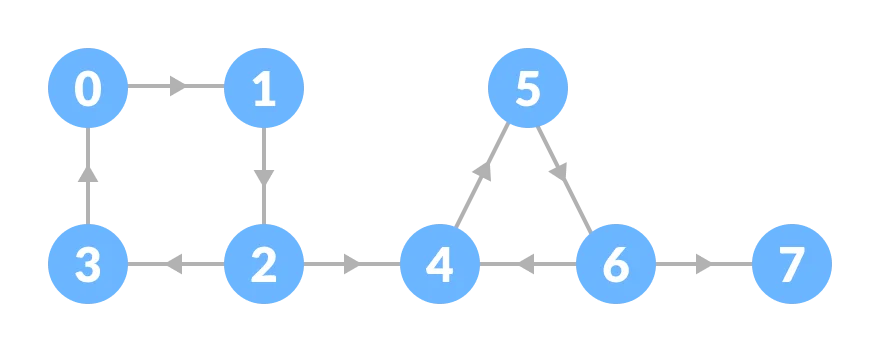
The graph above's highly related elements are:

As you can see, each vertex in the first strongly connected component has a directed path that allows it to reach every other vertex.
The Kosaraju Algorithm can be utilized to locate these elements.
The Kosaraju Algorithm
Double implementation of the depth-first search method is the foundation of Kosaraju's algorithm.
Kosaraju's Complexity of Algorithm
Kosaraju's algorithm executes in O(V+E), or linear time.
There are three phases in all.
Search the entire graph for depth-first.
Starting with vertex-0, we will visit each of its offspring vertices and mark those that have been visited as completed. A vertex should be pushed to the stack if it leads to a vertex that has previously been visited.
As an illustration, move from vertex-0 to vertex-1, vertex-2, and finally vertex-3. Put vertex-3, the source vertex, into the stack since it leads to vertex-0, which has already been visited.
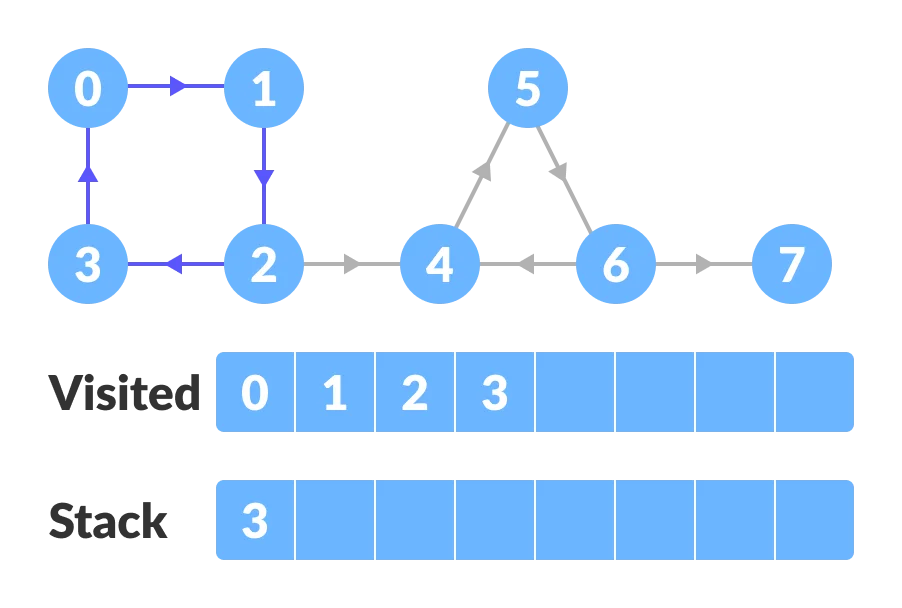
Visit the child vertices of the previous vertex (vertex-2), which are vertices-4,-5,-6, and-7, in that order. Vertex-7 has nowhere to go, so push it into the stack.

Visit the child vertices of the previous vertex (vertex-6). However, since every one of its descendant vertices has been visited, add it to the stack.
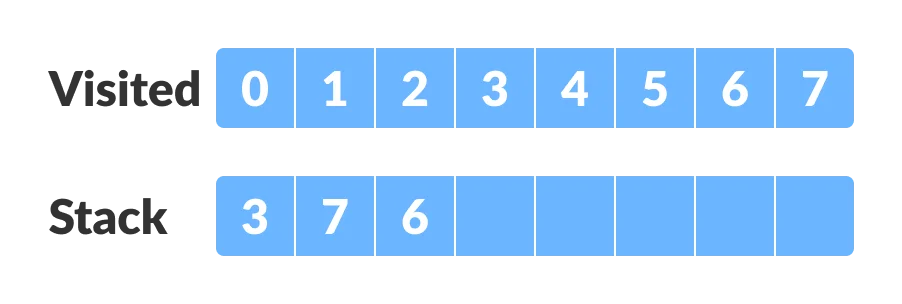
In the same way, a final stack is made.
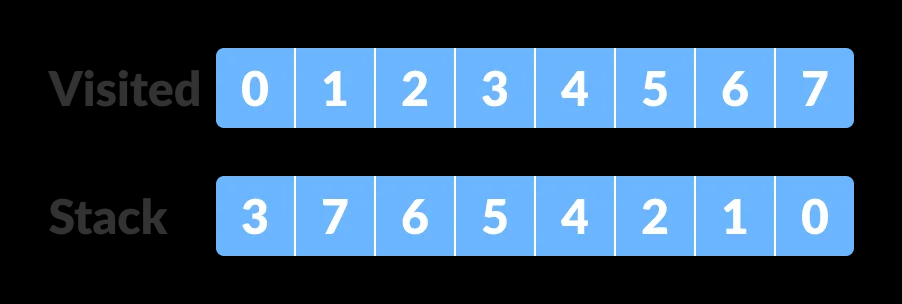
Turn the original graph around.
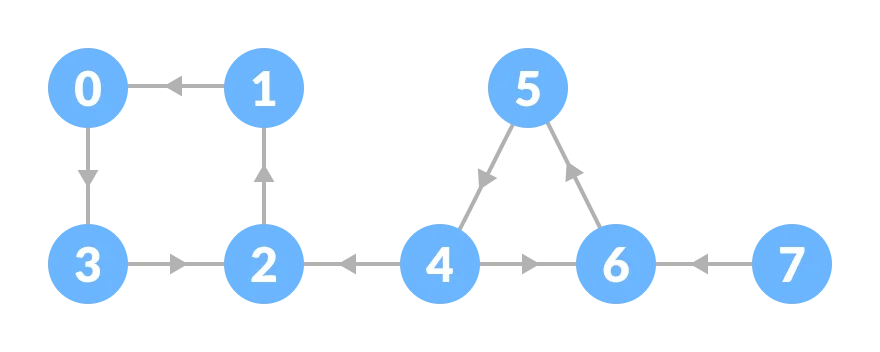
Utilize the inverted graph to conduct a depth-first search.
Start at the stack's uppermost vertex. Go over each of its offspring's vertices. One strongly connected component is produced after the already visited vertex is reached.
Take vertex-0 out of the stack, for instance. Navigate through each of the child vertices of vertex-0 (vertex-0, vertex-1, vertex-2, and vertex-3 in that order) and mark them as visited. Since vertex-3's child has already been visited, the visited vertices come together to form a single, tightly connected component.
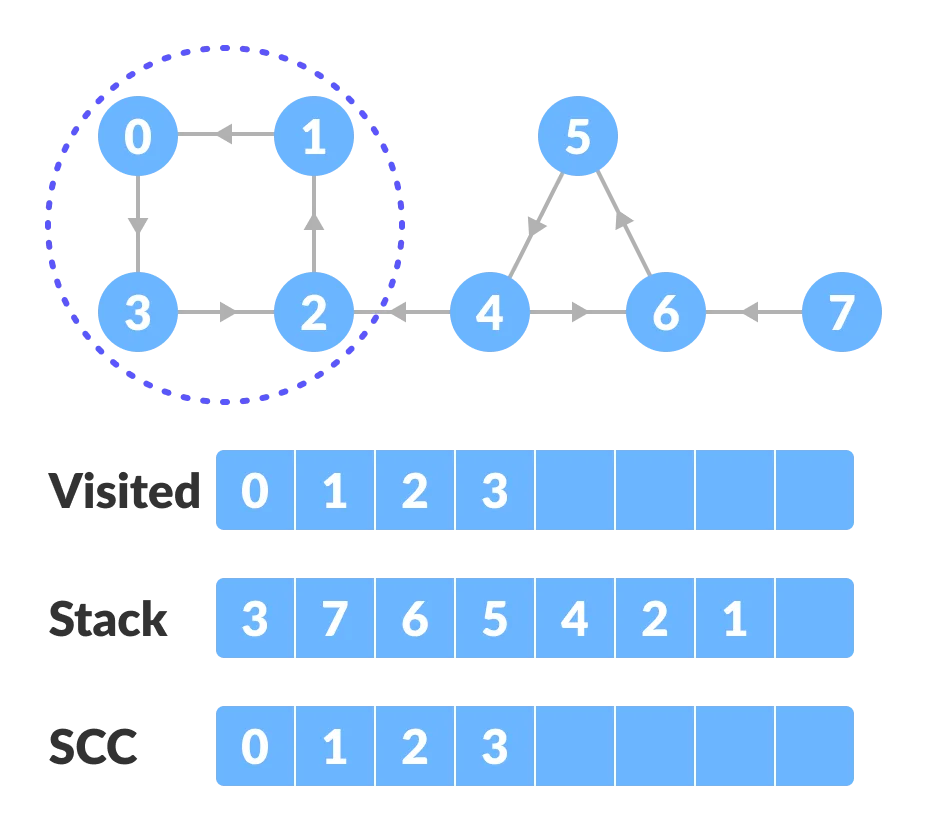
If you have already visited the top vertex, go to the stack and pop it. If not, select the top vertex in the stack and follow the previously described steps to navigate through its child vertices.
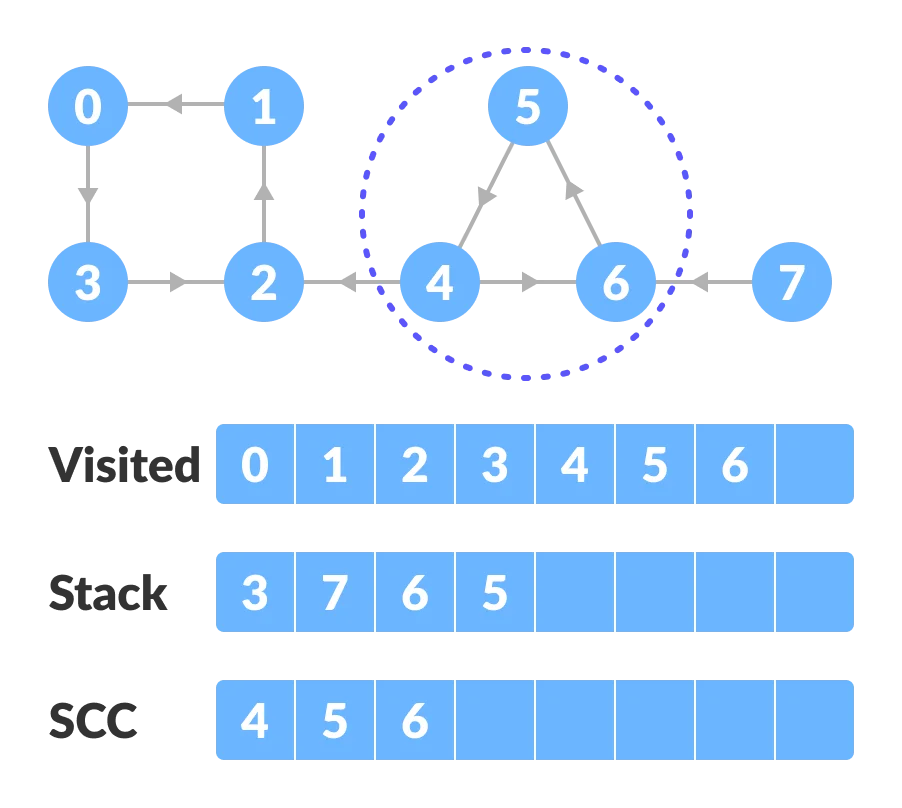
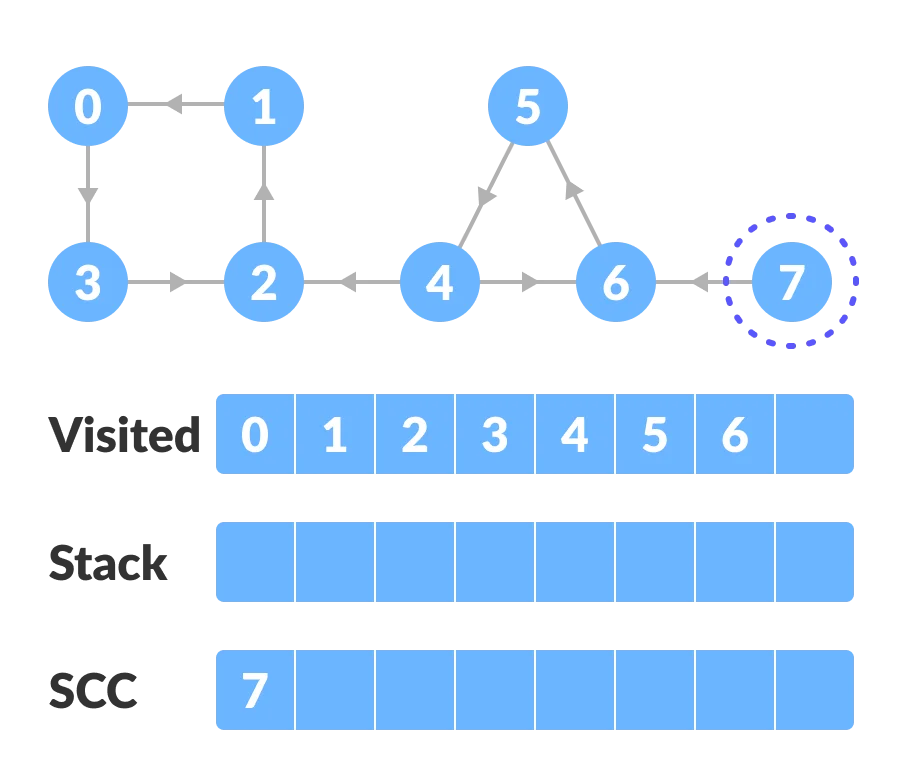
Therefore, the elements that are highly related are:
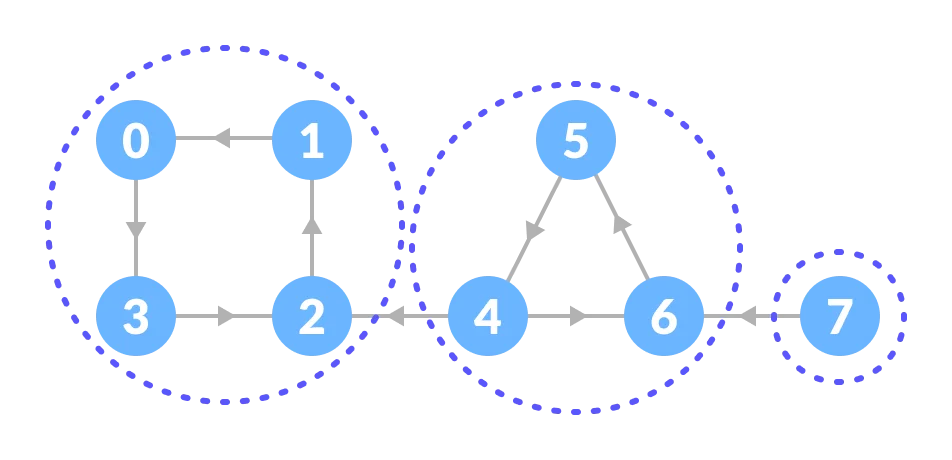
Here’s a Python Example:
from collections import defaultdict
class Graph:
def __init__(self, vertex):
self.V = vertex
self.graph = defaultdict(list)
# Add edge into the graph
def add_edge(self, s, d):
self.graph[s].append(d)
# dfs
def dfs(self, d, visited_vertex):
visited_vertex[d] = True
print(d, end='')
for i in self.graph[d]:
if not visited_vertex[i]:
self.dfs(i, visited_vertex)
def fill_order(self, d, visited_vertex, stack):
visited_vertex[d] = True
for i in self.graph[d]:
if not visited_vertex[i]:
self.fill_order(i, visited_vertex, stack)
stack = stack.append(d)
# transpose the matrix
def transpose(self):
g = Graph(self.V)
for i in self.graph:
for j in self.graph[i]:
g.add_edge(j, i)
return g
# Print stongly connected components
def print_scc(self):
stack = []
visited_vertex = [False] * (self.V)
for i in range(self.V):
if not visited_vertex[i]:
self.fill_order(i, visited_vertex, stack)
gr = self.transpose()
visited_vertex = [False] * (self.V)
while stack:
i = stack.pop()
if not visited_vertex[i]:
gr.dfs(i, visited_vertex)
print("")
g = Graph(8)
g.add_edge(0, 1)
g.add_edge(1, 2)
g.add_edge(2, 3)
g.add_edge(2, 4)
g.add_edge(3, 0)
g.add_edge(4, 5)
g.add_edge(5, 6)
g.add_edge(6, 4)
g.add_edge(6, 7)
print("Strongly Connected Components:")
g.print_scc()
Conclusion
Strongly connected components are the cornerstone concept in graph theory. They provide deep insights into the structure and dynamics of directed graphs.
From their theoretical foundation to practical applications in competitive programming and software engineering, they are indispensable tools used to analyze and optimize complex networks. By understanding the differences between strong and weak connected components and their related concepts, one can unlock new potentials in solving graph-related problems efficiently and effectively.
Frequently Asked Questions:
1. What are strong connection components?
Subgraphs in a directed graph where each vertex is reachable from every other vertex form strongly connected components (SCCs). What is the difference between connected vs. strongly connected components?
2. What is the difference between connected vs. strongly connected components?
In an undirected graph, a connected component is a subgraph where any two vertices are connected by a path. In a directed graph, a strongly connected component is a subgraph where every vertex is reachable from every other vertex within that subgraph. What are strongly connected components in competitive programming?
3. What are strongly connected components in competitive programming?
In competitive programming, strongly connected components are used to solve problems involving directed graphs, such as finding cycles, optimizing routes, and analyzing dependencies. What is the strongly connected theorem?
4. What is the strongly connected theorem?
The theorem of strong connectivity states that a directed graph can be broken down into its strongly connected components, which form the graph's unique partition. What are strong and weak connected components?
5. What are strong and weak connected components?
Strong connected components refer to subgraphs where every vertex is mutually reachable via directed edges. Weak connected components refer to subgraphs where vertices are connected if the direction of edges is ignored. What is the difference between strong and weak connected components?
6. What is the difference between strong and weak connected components?
Strong connected components consider the direction of edges, requiring mutual reachability. Weak connected components ignore edge direction, requiring only connectivity without considering direction. Is strongly connected component a cycle?
7. Is strongly connected component a cycle?
A strongly connected component can be a cycle if each vertex is reachable from every other vertex in a circular manner, but SCCs can also be more complex structures than simple cycles. What is the strongly connected core?
8. What is the strongly connected core?
The strongly connected core is the largest strongly connected subgraph within a directed graph, containing the maximum number of mutually reachable vertices. What are weakly connected components?
9. What are weakly connected components?
Weakly connected components are subgraphs of a directed graph where vertices are connected if edge direction is ignored, meaning there is an undirected path between any two vertices within the subgraph.

Author|417 articles published


upGrad Learner Support
Talk to our experts. We are available 7 days a week, 10 AM to 7 PM
Indian Nationals
Foreign Nationals
Disclaimer
The above statistics depend on various factors and individual results may vary. Past performance is no guarantee of future results.
The student assumes full responsibility for all expenses associated with visas, travel, & related costs. upGrad does not .
























